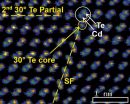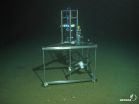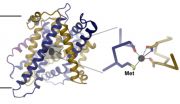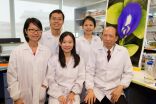INFORMATION:
Towards controlled dislocations
2014-10-20
(Press-News.org) Crystallographic defects or irregularities (known as dislocations) are often found within crystalline materials. Two main types of dislocation exist: edge and screw type. However, dislocations found in real materials tend to be a mix of these two types, resulting in a complex atomic arrangement not found in bulk crystals. The study of these dislocations in semiconductors is probably as old as the science of semiconductors itself, and the technological importance of dislocations can hardly be overstated. From their roles in the way crystals form to their effects on a material's mechanical, thermal and opto-electronic properties, dislocation and defects govern many aspects of a material's behaviour. Therefore, it is of great scientific interest to identify and study these structures, and understand their impact on the properties of technologically important materials and devices, such as solar cells, photon detectors and similar semiconductor devices.
Despite the large amount of theoretical work in this field, experimental knowledge detailing the atomically resolved chemical structure of even the most basic dislocations has just begun to be accessible. A group of scientists from the United States has combined state-of-the-art atomic-resolution Z-contrast imaging and X-ray spectroscopy in a scanning transmission electron microscope (STEM) to analyse two low-elastic-energy stair-rod dislocations in the binary II-VI semiconductor CdTe. CdTe is commercially used in thin-film photovoltaics owing to its ideal electrical properties. The conversion efficiency of CdTe solar cells, which is critical for the industry, has only seen minor developments and improvements over the last 20 years despite intense research activity. Current laboratory records are still shy of the theoretical limits quoted as far back as 1961.
In the current issue of Acta Crystallographica Section A: Foundations and Advances, Klie and co-workers demonstrate how, with the use of atomic-resolution STEM images and specially tailored Burgers circuits, the structure of these dislocations can be identified [Paulauskas et al. (2014). Acta Cryst. A70; doi:10.1107/S2053273314019639]. The results may lead to the eventual improvement in the conversion efficiency of CdTe solar cells. The analysis presented by the authors can also be applied to study and predict similar structures in other zinc-blende and diamond materials. This study further demonstrates how the new generation of aberration-corrected electron microscopes can advance our understanding of seemingly basic crystal-structure defects.
ELSE PRESS RELEASES FROM THIS DATE:
Cold sores increase the risk of dementia
2014-10-20
Infection with herpes simplex virus increases the risk of Alzheimer's disease. Researchers at Umeå University, Sweden, claim this in two studies in the journal Alzheimer's & Dementia.
"Our results clearly show that there is a link between infections of herpes simplex virus and the risk of developing Alzheimer's disease. This also means that we have new opportunities to develop treatment forms to stop the disease," says Hugo Lövheim, associate professor at the Department of Community Medicine and Rehabilitation, Geriatric Medicine, Umeå University, who is ...
Pediatric allergology: Fresh milk keeps infections at bay
2014-10-20
A study by researchers of Ludwig-Maximilians-Universitaet (LMU) in Munich shows that infants fed on fresh rather than UHT cow's milk are less prone to infection. The authors recommend the use of alternative processing methods to preserve the protectants found in the natural product.
A pan-European study, led by Professor Erika von Mutius, Professor of Pediatric Allergology at LMU and Head of the Asthma and Allergy Department at Dr. von Hauner's Children's Hospital, reports that fresh cow's milk protects young children from respiratory infections, febrile illness and inflammation ...
The breathing sand
2014-10-20
A desert at the bottom of the sea? Although the waters of the North Sea exchange about every two to three years, there is evidence of decreasing oxygen content. If lower amounts of this gas are dissolved in seawater, organisms on and in the seabed produce less energy – with implications for larger creatures and the biogeochemical cycling in the marine ecosystem. Since nutrients, carbon and oxygen circulate very well and are processed quickly in the permeable, sandy sediments that make up two-thirds of the North Sea, measurements of metabolic rates are especially difficult ...
Biomarkers uPA/PAI-1 in breast cancer: Benefit and harm of the test unclear
2014-10-20
To make a decision for or against adjuvant chemotherapy, a test to measure the concentrations of the biomarkers uPA and PAI-1 in the tumour tissue is available for breast cancer patients. However, as suitable studies are lacking, it remains unclear for patients with an intermediate risk of recurrence which benefit or harm a treatment strategy based on this test may have for them. This is the result of the final report published by the Institute for Quality and Efficiency in Health Care (IQWiG) on 20 October 2014.
Adjuvant systemic treatments aim to prolong survival
Even ...
NUS-led research team develops novel solutions to fight the obesity gene
2014-10-20
Individuals who are genetically predisposed to obesity may soon have a therapeutic solution to combat their condition. A research team led by scientists from the National University of Singapore (NUS) has identified several potent inhibitors that selectively target FTO, the common fat mass and obesity-associated gene. These FTO-specific inhibitors pave the way for the development of novel anti-obesity drugs and treatments.
The research, led by Assistant Professor Esther Woon from the Department of Pharmacy at the NUS Faculty of Science, along with colleagues from the ...
Sexual preference for masculine men and feminine women is an urban habit
2014-10-20
In a world of matinee idols and cover girls it's easy to assume that humans want their men to be manly and their women womanly.
But a groundbreaking new study suggests that, rather than being a preference passed down through a long process of social and sexual selection, it's a relatively new habit that has only emerged in modern, urbanised societies.
A team of psychologists, anthropologists and biologists, led by Brunel University London, surveyed 12 populations around the world, from the primitive to the highly developed.
Surprisingly, only in the most industrialised ...
Structure of an iron-transport protein revealed
2014-10-20
Iron is the most abundant trace element in humans. As a cofactor of certain proteins, it plays an essential role in oxygen transport and metabolism. Due to the major importance of iron in a wide variety of cellular processes, and the harm caused by its uncontrolled accumulation in the body, its uptake and storage is strictly regulated. In mammals, iron is imported into cells by the membrane transport protein DMT1. Mutations of DMT1, which affect its transport properties, lead to iron-related metabolic disorders such as anemia and the iron storage disease hemochromatosis.
Ines ...
Scientists create possible precursor to life
2014-10-20
How did life originate? And can scientists create life? These questions not only occupy the minds of scientists interested in the origin of life, but also researchers working with technology of the future. If we can create artificial living systems, we may not only understand the origin of life - we can also revolutionize the future of technology.
Protocells are the simplest, most primitive living systems, you can think of. The oldest ancestor of life on Earth was a protocell, and when we see, what it eventually managed to evolve into, we understand why science is so fascinated ...
No added benefit proven for umeclidinium/vilanterol in COPD
2014-10-20
The drug combination umeclidinium/vilanterol (trade name Anoro) has been approved since May 2014 for adults with chronic obstructive pulmonary disease (COPD). In an early benefit assessment pursuant to the Act on the Reform of the Market for Medicinal Products (AMNOG), the German Institute for Quality and Efficiency in Health Care (IQWiG) examined whether this drug combination offers an added benefit over the appropriate comparator therapy.
According to the findings, an added benefit is not proven: For patients with moderate COPD severity and patients with fewer than ...
NTU scientists discover new molecule from local herb with potential for drug development
2014-10-20
Scientists at Nanyang Technological University (NTU Singapore) have discovered a new molecule which can join together chains of amino acids – the building blocks of protein.
Only three other known molecules have been discovered to be able to perform this function, which is an important process in the development of new drugs. A key difference is that the new molecule is able to do the same process 10,000 times faster than the other three and "cleanly" without leaving any residue behind.
This new molecule, which is a type of catalyst or enzyme, was derived from ...




